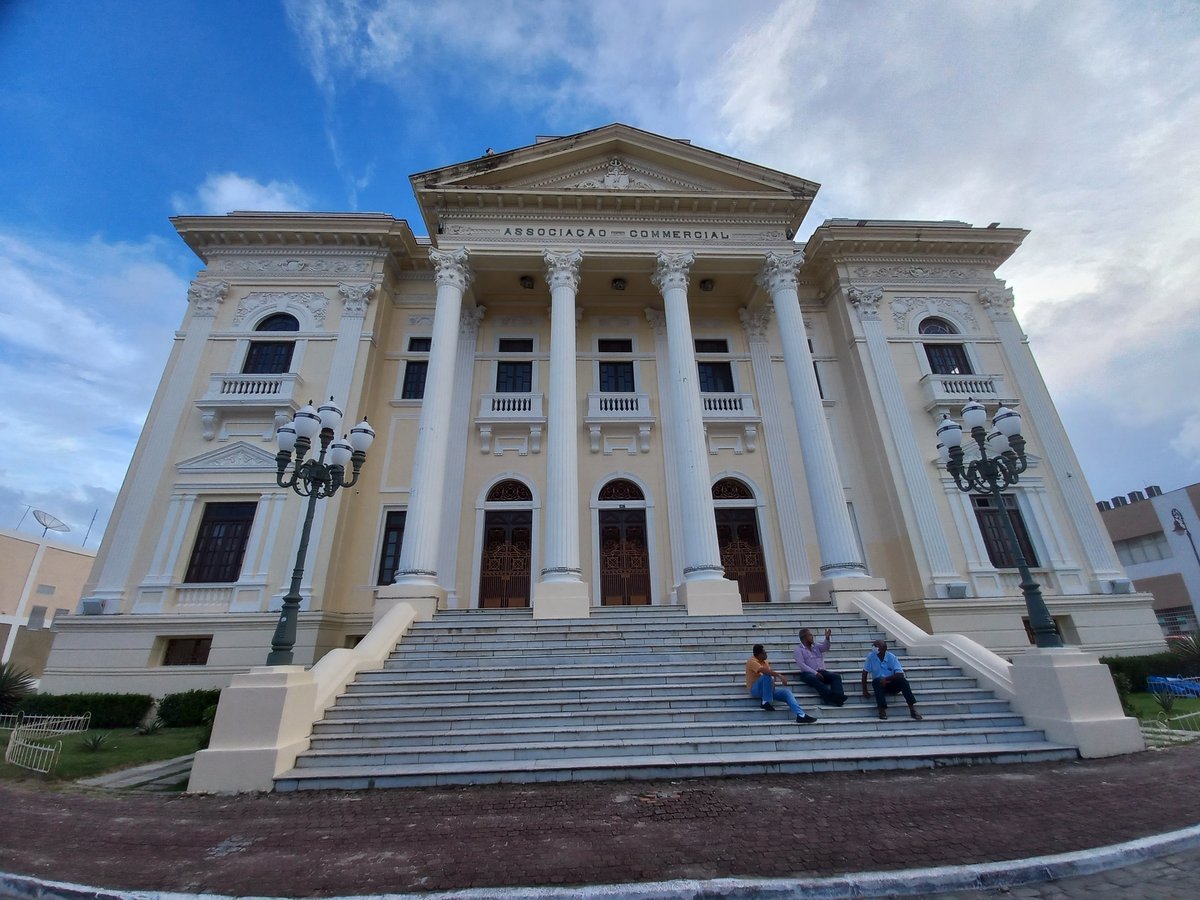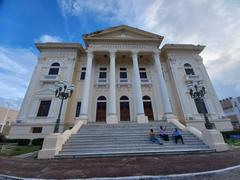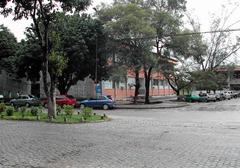
Associação Comercial De Maceió: Visiting Hours, Ticket Information, and Historical Guide
Date: 14/06/2025
Introduction
Nestled in the historic Jaraguá district of Maceió, Brazil, the Associação Comercial De Maceió (ACMaceió) stands as a testament to the city’s vibrant commercial legacy and rich cultural heritage. Founded in 1866, ACMaceió has played a pivotal role in Alagoas’s economic development, evolving alongside Maceió from a thriving port town into a bustling commercial hub. Its headquarters, the iconic Palácio do Comércio, inaugurated in 1928, is an architectural landmark that embodies both the prosperity and social aspirations of the region. Today, ACMaceió welcomes visitors to experience its history, architecture, and ongoing contribution to the community.
For detailed visitor information, special event schedules, and updates, please refer to the official ACMaceió website and the Audiala app (Palácio do Comércio Maceió, Bairros de Maceió - Jaraguá, Visit Brasil - Maceió).
Table of Contents
- Historical Background
- Architectural and Cultural Significance
- Visiting Information
- Preservation and Modern Community Engagement
- Visitor Experience and Nearby Attractions
- Frequently Asked Questions (FAQ)
- Plan Your Visit and Stay Connected
- Conclusion
- References and Useful Links
Historical Background
Foundation and Early Years (1866–1920)
ACMaceió was established on July 22, 1866, by José Joaquim de Oliveira to support local merchants and foster economic development. Early on, the association distinguished itself through advocacy for social progress, including the emancipation of the enslaved woman Bemvinda. Over subsequent decades, ACMaceió became a prominent representative of the region’s business community, influencing commerce and industry across Alagoas.
Construction and Role of Palácio do Comércio (1920–1940)
As the association grew, Francisco Polito spearheaded the construction of the Palácio do Comércio, inaugurated in 1928. The building’s monumental neoclassical design—with Greco-Roman columns and ornate façades—signified both economic power and civic pride. Beyond serving as ACMaceió’s headquarters, the palace historically accommodated the state judiciary, legislative assembly, and municipal chamber, making it a central hub for civic life in Maceió.
Architectural and Cultural Significance
Architectural Features
The Palácio do Comércio is a prime example of neoclassical and Greco-Roman architectural influence, constructed by Francisco Lopes de Assis Silva & Cia (also builders of Rio’s Palácio Tiradentes). Its stately façade, marble staircases, and elegant lighting reflect the wealth and aspirations of Maceió’s merchant elite during the sugar and cotton trade booms. The interior boasts high ceilings, detailed moldings, and period furnishings, offering visitors an authentic historical atmosphere (blog.kurby.ai).
Symbolism and Community Role
The building is deeply linked to Alagoas’s economic evolution, particularly the sugar and cotton industries, serving as a gathering place for influential business figures. ACMaceió’s history mirrors the city’s commercial growth and social transformations, making the Palácio do Comércio a living monument to justice, prosperity, and civic engagement (bairrosdemaceio.net).
Visiting Information
Visiting Hours and Admission
- Monday to Friday: 9:00 AM – 5:00 PM
- Saturday and Sunday: Closed
- Admission: Free entry for general visits. Special exhibitions or guided tours may require a nominal fee—confirm details in advance.
Accessibility
ACMaceió is committed to accessibility, with ramps and elevators available for visitors with disabilities. Please contact the association ahead of your visit for specific accessibility needs.
Guided Tours and Special Events
- Guided Tours: Available by advance booking, typically Monday to Friday. Weekend and public holiday tours may be offered during special events.
- Special Events: ACMaceió hosts cultural festivals, exhibitions, lectures, and business forums throughout the year. Check the official website or local tourism resources for current schedules.
Location and Transportation
Located in the heart of Maceió’s historic downtown (Jaraguá district), ACMaceió is within walking distance of key attractions, including the Metropolitan Cathedral and Handicraft Market. The area is served by public transportation and ride-sharing services such as Uber and 99 (nextstopbrazil.com).
Visitor Amenities
- Facilities: Restrooms, a café, and a gift shop are available on-site.
- Photography: Permitted in most areas; flash use may be restricted in exhibition spaces.
- Information: Interpretive materials and staff are available to assist visitors.
Preservation and Modern Community Engagement
Recognized as a protected heritage site since 1983 under Decree No. 5.304, the Palácio do Comércio benefits from ongoing restoration efforts supported by local heritage organizations (bairrosdemaceio.net). ACMaceió continues to provide business development resources, training, and digital certification services, and frequently collaborates with organizations like SEBRAE to support local enterprises and social initiatives.
Visitor Experience and Nearby Attractions
What to See and Do
- Architectural and Historical Tours: Explore the neoclassical façade, marble staircases, and period interiors.
- Exhibitions: Discover archival materials and artifacts chronicling Maceió’s commercial evolution.
- Cultural Events: Attend lectures, concerts, and artisan fairs.
- Networking: Business travelers can connect with local entrepreneurs.
Nearby Attractions
- Jaraguá Historic District: Colonial-era buildings and vibrant urban character.
- Metropolitan Cathedral: A neocolonial architectural landmark.
- Théo Brandão Museum: Folk art and regional history (visitbrasil.com).
- Handicraft Market: Over 250 stalls with local crafts.
- Rua das Rendeiras (Pontal da Barra): Lace-making tradition and artisan community.
Frequently Asked Questions (FAQ)
Q: What are ACMaceió’s visiting hours?
A: Monday to Friday, 9:00 AM – 5:00 PM. Closed on weekends. Verify hours during special events or holidays.
Q: Is there an entrance fee?
A: General entry is free. Some events or guided tours may require a small fee.
Q: Are guided tours available?
A: Yes, by advance booking. Check availability and event schedules online.
Q: Is ACMaceió accessible for people with disabilities?
A: Yes, with ramps and elevators for accessibility.
Q: Can I take photographs?
A: Photography is permitted, except where restricted for preservation.
Q: What nearby sites should I visit?
A: Explore the Jaraguá district, Metropolitan Cathedral, Théo Brandão Museum, and Handicraft Market.
Plan Your Visit and Stay Connected
- Check the latest hours and event information on the official ACMaceió website.
- Download the Audiala app for guided tours, digital maps, and local insights.
- Follow ACMaceió and Audiala on social media for updates on exhibitions, festivals, and heritage initiatives.
Conclusion
The Associação Comercial De Maceió is more than a historical building—it’s a dynamic institution at the heart of Maceió’s commercial, cultural, and civic life. Its neoclassical architecture, rich archives, and ongoing programming make it a must-visit for anyone seeking to understand the city’s heritage and contemporary vitality. Take advantage of free admission, accessible facilities, and curated tours to immerse yourself in Maceió’s past and present. Extend your visit to the surrounding historic district for a complete cultural experience.
Plan your visit today and discover the landmark where history, architecture, and community converge in Maceió, Brazil’s vibrant northeast.
References and Useful Links
- Palácio do Comércio Maceió
- Bairros de Maceió - Jaraguá
- Visit Brasil - Maceió
- Em Algum Lugar do Mundo - O que fazer em Maceió, Alagoas
- From Past to Present: The Evolution of Maceió, Brazil’s Architecture
- Next Stop Brazil - Maceió
- Maceió Tourism Board


